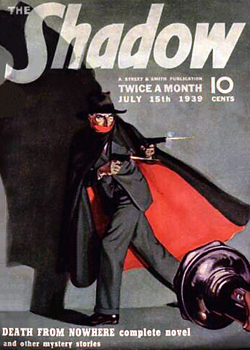Heroes of
Pulp - Part 1 - The Shadow
The early
pulps were often defined and collected based on similar themes and genres.
Short stories by any number of authors could be found in a magazine because
they shared some common element. But during the Depression, as sales in the
pulps began to dwindle, there was a growing interest in specific characters.
Readers of comic books, a growing trend at the time, wanted stories connected
by a single hero. Thus the first character pulps were born.
One of the
first of these character magazines was the immensely popular The Shadow. In
1930, Street & Smith were broadcasting a very popular radio program called Detective Story Hour. This was a
dramatized version of stories found in their Detective Story Magazine, one of
the most well read detective pulps in history. The narrator of this program was
a mysterious voice known only as The Shadow. Due to fans enjoyment of the
character, the publisher decided to attempt to make stories based around him.
Editor Walter B. Gibson was hired to devise the novels that would be featured
in a new magazine. With little background or character developed for the radio
narrator, Gibson had free reign to create a memorable and enjoyable character.
Debuting in
1931 as a quarterly, The Shadow's first tale, "The Living Shadow",
was an instant success. The later sequels would cement The Shadow as one of the
most popular and influential pulp characters of all time. In fact, much of what
we think of as "pulp" in style, is typified in the Shadow stories.
Rather than rely on gritty realistic crime stories, like those being published
by Black Mask, Gibson took his adventure story influences and applied them to
mystery, creating one of the first crime-fighting superheroes.
The unprecedented
success of the magazine drove publishers to push it from being a quarterly
print to monthly, and then eventually bi-weekly by 1932. Because writing a
novel-length story every two weeks would kill any writer, the publishers
assumed that Gibson would need the help of ghost writers. But Gibson was able
to keep up with the new pace of printing for the next decade. Though the
stories were purely written by Gibson, he made good use of brainstorming
sessions with Street&Smith executives and editors to help keep the ideas
flowing.
At its
height, the magazine was selling over 300,000 copies per issue. That is a sales
record not even seen today in the most popular of mainstream comics. Despite
Gibson's limited writing skill and the lackluster prose of The Shadow, readers
were hooked. By 1937, Gibson had penned over a hundred novels featuring the
character. After so long a time, elements of previous stories began to
reappear. Though most pulps of this type follow a formula to aid in the writing
of so many stories, the later stories of Gibson's began to show their
staleness. In a last ditch effort to find a sense of freshness, Gibson penned
"The Shadow Unmasks". The story, meant to draw in readers by finally
revealing the true identity of the titular hero, was a flop. After the story's
publication, the magazine began to see a slow decline in sales.
Also in
1937, after a brief hiatus, The Shadow returned to airwaves. The new show was
met with mediocre success as changes to the written version of the character
did not sit well with avid readers. Changes were made to the character's now
iconic costume as well as giving him strange psychic powers. The new series'
Shadow was voiced by none other than Orson Welles, who was later replaced for a
more popular actor at the time. Orson Welles would then leave the radio show
business (for a while) to try his hand at filmmaking. His debut film, Citizen
Kane, would be released four years later. Eventually the new radio series found
its audience and grew back into the success it had once seen before. The
success of the program eventually pushed publishers to work many of the changes
into the print version of the character.
By the '40s,
The Shadow was reduced in size and frequency (more out of war-time rationing
than a plummet in sales). With the war quickly becoming the center of attention
in America, the spotlight dimmed on crime-fighters and their sinister villains.
After a number of poorly received stories in the mid-'40s, Gibson eventually
left the magazine after a number of salary disputes. Though temporarily
replaced, Gibson would eventually return after the stories written in his
absence were even more poorly received by readers and fans. It was short lived
however and 1949, nineteen years after his debut, The Shadow retired (though he
continued to seek justice on the airwaves for another 5 years).
The
influence of The Shadow was wide spread. It changed many publishers opinions of
what to focus on in their prints. The instant popularity of a magazine that
focused solely on a single character could be felt throughout the publishing
world. The character itself would influence the creation of many other great
pulp heroes (some of whom we will look at soon), but he would also continue to
live on in his own right. In the gaming communities of today, especially in the
world of roleplaying, the influence of the pulps can still be felt. Homages and
parodies of the Shadow have turned up in any number of places. He has starred
in new audio dramas, novels and comic book series. And in 1994, a film
adaptation of the character was made starring Alec Baldwin. A film which,
despite its mediocre returns, still has its own cult following.
Recommended Stories:
"The Romanoff Jewels (1932)
"The Grey Fist" (1934)
"The Cobra" (1934)
"Zemba" (1935)
"Bells of Doom" (1935)
"The Voodoo Master" (1936)





No comments:
Post a Comment